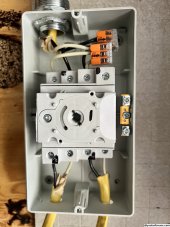Actually it was
@Quattrohead 's comment (credit where credit is due!)
And the light bulb is a great idea, since it will tell you (and us) if there is a short in one of the inverters/between them since the light bulb should slowly dim as the capacitors charge up, BUT IF THERE IS A SHORT the bulb will NOT DIM.
I am starting to wonder if the addition of the second inverter is where things went sideways - not set up/connected correctly creating a short circuit somewhere that was able to trip those Class T fuses - I find it hard to imagine the capacitor in-rush alone would be sufficient to blow those Class T fuses.
It has already been said, I will say I agree with this: disconnect everything from each inverter - start with one, leave the Class T fuse out of the circuit so you can put the light bulb across the gap. connect just the battery pos and neg - nothing else try the light bulb trick to see if it lights and dims. This would at least confirm no short in inverter #1, if all good, you can then install the class T and check inverter #1 will start up and display works.
Then repeat with inverter #2 Alone - just the inverter and again remove the Class T fuse to make a gap for the light bulb trick, battery pos battery neg attached to the inverter. light bulb trick again see if it lights then dims. If it doesn't dim there is a short somewhere, don't install the class T fuse, don't supply battery directly to the inverter - look for the short



